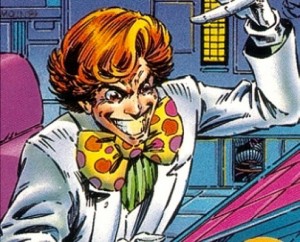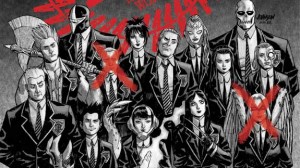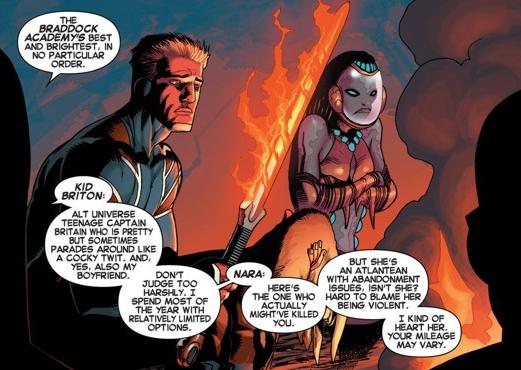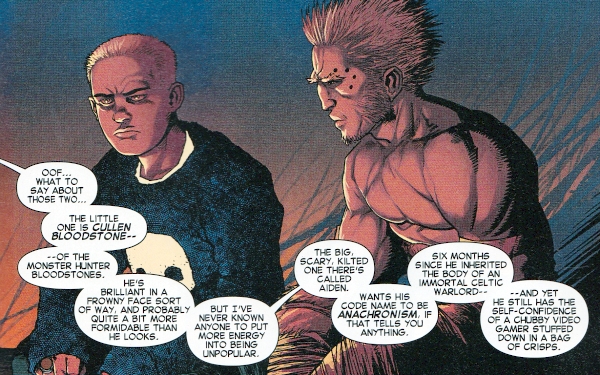By Pat French
One of my favorite sub-types of the Superhero genre is that of the teen hero. Whether this is the classic X-Men (or the subsequent New Mutants, Generation X et. al.), the protégé team-ups such as Teen Titans or Young Avengers, or original standalone super-teen books like Runaways or Young Allies, I’ve always enjoyed the dynamics inherent in stories about super-powered kids. In books centering on adult heroes we take their goodliness for granted. Generally their origin stories tell it all (great power=great responsibility and all that). They’re good because being a superhero is their job. They’re adults who have made their decisions and learnt the necessary lessons from life already. We can respect and look up to them (hence hero). With books about youngsters all of that is thrown out the window. We get to see them develop and grow. We feel their anguish more strongly because for most of us non-heroic types there are remnants of teen trauma rolling around our subconscious. When a young hero makes a bad decision we can usually identify where they’re coming from. When they make the right decision we feel overwhelming fondness. From the youth comes the greatest purity and the deepest vulnerability. When they grow up and earn a place with the big boys (such as Dick Grayson’s ascent from Robin to Nightwing) we couldn’t be more proud.
Writer Dennis Hopeless knows that we love these kids. That’s why he’s killing them all. Today I’d like to talk about the controversial Marvel Now series Avengers Arena, and why, despite it lining some of my favorite characters up to the chopping block, I think it’s actually quite good.
So for the comic world virgins amongst ya’ll I’ll try and summarize this as simplistically as possible. Avengers Arena is about a Super-Villain from the 80’s kidnapping a bunch of superkids, trapping them on an island, and forcing them to play a deadly game of last-teen-standing. Now, I know what you’re thinking. That sounds just like the plot to The Hunger Games. To which I would reply “well yeah, but the Hunger games is totally ripping off Battle Royale. And for that matter, isn’t Battle Royale just an amalgamation of Lord of the Flies and Enders Game?” And then we’ll digress to the subject of Orson Scott Card being a gay-hating bigot, and by that point we’ve stopped talking about comics. And no one wants that.
Anyhoo, the whole rip-off discussion is a moot point to begin with. Arcade (the aforementioned 80’s Super-Villain) admits to stealing the idea in issue 1. What’s more discussable is the fact that Marvel has seemingly lined up 16 of their pubescent characters to off one another. And these aren’t just lame characters no one cares about (for the most part). This series picks up where the fan favorite series Avengers Academy ended and has already killed or disfigured several characters from that. This has (of course) lead to a sizable dosage of fan-bitching. Mettle, a very likeable and important character from Avengers Academy died to protect his girlfriend, Hazmat. It was shocking and bloody in a way so few comics from the big two dare. This was no Death of Superman where Mettle dies defeating a powerful villain. No siree, this kid went down like a punk. And this is where the fan-bitchiness began.
Now, I followed Mettle’s arc from shiny beginning to messy end and I will admit, it was sad to see him go. Some folks however have taken things a little too far, sending death threats to series writer Dennis Hopeless and even starting an online poll to get the series cancelled and all the events within retconned. These sadsacks seem to be of the opinion that Marvel is sacrificing their young and less developed characters for the sake of sales. I, for one, would like to take the opposing position. It’s all too rare in super hero comics that we get to see real drama like this. Is it a shame that Mettle is dead? Of course it is. That’s what makes it captivating and exciting. That’s what makes it dramatic.
Immediately after Mettle’s demise, Red Raven (who if memory serves is from an early 2000’s Captain Marvel arc) attempts to fly off the island and snaps her neck on what appears to be a forcefield. So that’s 2 down, one much loved young hero and one sorta forgotten young heroine (and I might note that nobody raised any sort of ruckus about her dying. Come on Comic fans! Where’s the gender equality at?). So this leaves us with a couple survivors from Avengers Academy, Some newly created characters from the England’s Braddock Academy, A 13-year-old cold-as-ice Space pirate named Cammi (who some may remember from the Drax the Destroyer and Annihilation mini-series), a couple punks from Brian K. Vaughn’s magnificent series Runaways, a pre-pubescent cyborg of the Deathlok variety, and for some reason Darkhawk.
As I mentioned before, the fan-hatred this series is getting seems to stem from the idea that Marvel is writing off these characters (note how there’s no X-kids in the bunch. According to Arcade, Wolverine’s school simply had better locks). The real bitterness I think comes from the inclusion of the Runaways, a series that was most certainly a cut above most things Marvel. But as I said before, this is the meat of what makes this series so dang dramatic. On top of that, this is the Marvel Universe we’re talking about. Even if every kid on this island dies, some other writer will find a convoluted reason to bring them back down the line. And on that note part of what made Runaways so excellent was the vulnerability and mortality of it’s cast. Vaughn himself killed several of them, making this fan backlash both immature and unfounded.
But that’s enough name-calling from me. Right now I ‘d like to talk about the aspects of this book that has made it one of my favorites. First of all, the Braddock Academy kids are all interesting and provocative additions to the Marvel Universe. At first (seeing as they’re the kids created for this series) they seemed to be more or less cannon fodder. Issues 5 and 6 however brought us into their world, and I have to admit to wanting to see more of them in future projects. You know, if they don’t all die by the series’ conclusion. We’ve got a young version of Captain Britain (long story short, there’s a Captain Britain in every universe, and this dude is the angry teen version), an angry Atlantean chick named Nala, Cullen Bloodstone (of the monster-huntin’ Bloodstones don’cha’know), the enigmatic flight-powered Apex, and a geek in the body of a Celtic Barbarian named Anachronism. By issue 2, Apex convinces this alliance to accept the scared little cyborg girl, whom they dub Deathlocket. As the series progresses, our perception of who is to be reckoned with in this group changes dramatically. Because these characters have no prior backstory, their actions and reactions to Arcade’s tormenting have kept me on my toes and surprised me in wonderful ways.
Secondly, I’d like to speak about how this series turns the crossover concept on it’s head. Like many superhero fans, I’ve always loved a good crossover. There’s just something great about seeing the X-Men and the Avengers team up. Whether it’s seeing how different power-sets can be combined or just seeing which girls (or guys for that matter) swoon when they meet Thor, there’s just something intrinsically kick-ass about a good crossover. The generic super-hero crossover goes a little like this: Hero A meets Hero B, they fight each other for a minute because the story’s villain tricked them, reconciliation occurs, and they combine forces to take down the devious villain. In Avengers Arena we have the opposite of this. The various teen heroes, most of whom have not met one another, immediately identify Arcade as the villain and try to team up to stop him. Arcade knocks them on their collective asses and tells them that that shit is not gonna fly (in the case of Red Raven quite literally). They then reluctantly split into their respective groups and mostly keep to themselves. It’s only when hunger and paranoia sets in that they begin to turn against one another. They go from a position of unified strength to a state of distrust and temporary alliances that puts Survivor to shame. The various corners of the Marvel U these characters represent is also well balanced. The Marvel universe is delightfully varied and it is nice to see a book that acknowledges this.
Thirdly, I simply love Kev Walkers art. The dark gritty style this series has been drawn in fully compliments its dismal concept. He does this great thing when characters first appear in each issue where he displays a videogame-esque life bar next to their name, keeping you appraised of how each character is doing. The desperation and tension between the characters is palpable and engaging. Best of all unlike some artists (COUGH* ROB LIEFIELD*COUGH COUGH), Walker keeps the characters looking believably young and realistic (excepting of course Kid Briton, Mettle, and Anacronism who’s powers beef them up beyond normal teenager size). I can’t stress enough how much I hate it when artists make teenagers look like 30-year-old cover girls.
 Lastly, I simply love what Dennis Hopeless has done with Arcade. Although a neat concept, he has been a historically lame character. Arcade was created in the late 70’s by the great Chris Claremont as an international assassin who specializes in creating intricate death traps, much like The Man with the Golden Gun’s Scaramanga. His modus operandi is to construct a giant obstacle course (dubbed Murderworld) and force heroes to attempt to survive it. Sure this sounds cool and all, except for the fact that since his first appearance, we’ve rarely seen anyone die in any of his various incarnations of Murderworld. On top of that he’s a slight little dandy who rarely deigns to throw down when the hero inevitably escapes his traps. Now I know it’s sacrosanct to ponder the financial woes of a supervillain, but one has to wonder when this guy might try simplifying his approach. Well Dennis Hopeless appreciates this sort of question, and has had Arcade finally up his game. He kidnaps these kids not to fulfill a contract, but to restore his fractured reputation by murdering the hero community’s young protégés. Murderworld, instead of being a giant pinball machine, is a deadly domed island with a climate control system allowing for bordering desert and snow regions. Additionally, he displays new powers of the telekinetic (or something) variety, easily trouncing the 16 young heroes in the first issue. Theories abound that this might not actually be Arcade (something that would make me a sad panda) but nonetheless, we finally have a good use for this colorful and interesting madman.
Lastly, I simply love what Dennis Hopeless has done with Arcade. Although a neat concept, he has been a historically lame character. Arcade was created in the late 70’s by the great Chris Claremont as an international assassin who specializes in creating intricate death traps, much like The Man with the Golden Gun’s Scaramanga. His modus operandi is to construct a giant obstacle course (dubbed Murderworld) and force heroes to attempt to survive it. Sure this sounds cool and all, except for the fact that since his first appearance, we’ve rarely seen anyone die in any of his various incarnations of Murderworld. On top of that he’s a slight little dandy who rarely deigns to throw down when the hero inevitably escapes his traps. Now I know it’s sacrosanct to ponder the financial woes of a supervillain, but one has to wonder when this guy might try simplifying his approach. Well Dennis Hopeless appreciates this sort of question, and has had Arcade finally up his game. He kidnaps these kids not to fulfill a contract, but to restore his fractured reputation by murdering the hero community’s young protégés. Murderworld, instead of being a giant pinball machine, is a deadly domed island with a climate control system allowing for bordering desert and snow regions. Additionally, he displays new powers of the telekinetic (or something) variety, easily trouncing the 16 young heroes in the first issue. Theories abound that this might not actually be Arcade (something that would make me a sad panda) but nonetheless, we finally have a good use for this colorful and interesting madman.
In conclusion and summation, Avengers Arena is an interesting and provocative series that presents dramatic and powerful moments between Marvel’s youngest and most vulnerable characters. I would definitely classify it as new reader friendly so if you’ve never read a comic or it’s been a while, this is something I recommend trying out. It is this writer’s opinion that the controversy surrounding the series is unfounded and silly and that fans of Marvel should most certainly give it a try. It not only introduces new characters but brings existing characters to dark places we’ve yet to see them explore. It is published bi-weekly, the first 6 issues are already available and issue 7 shall be out April the 10th. As a long time Marvel comics fan, I highly recommend checking it out.



